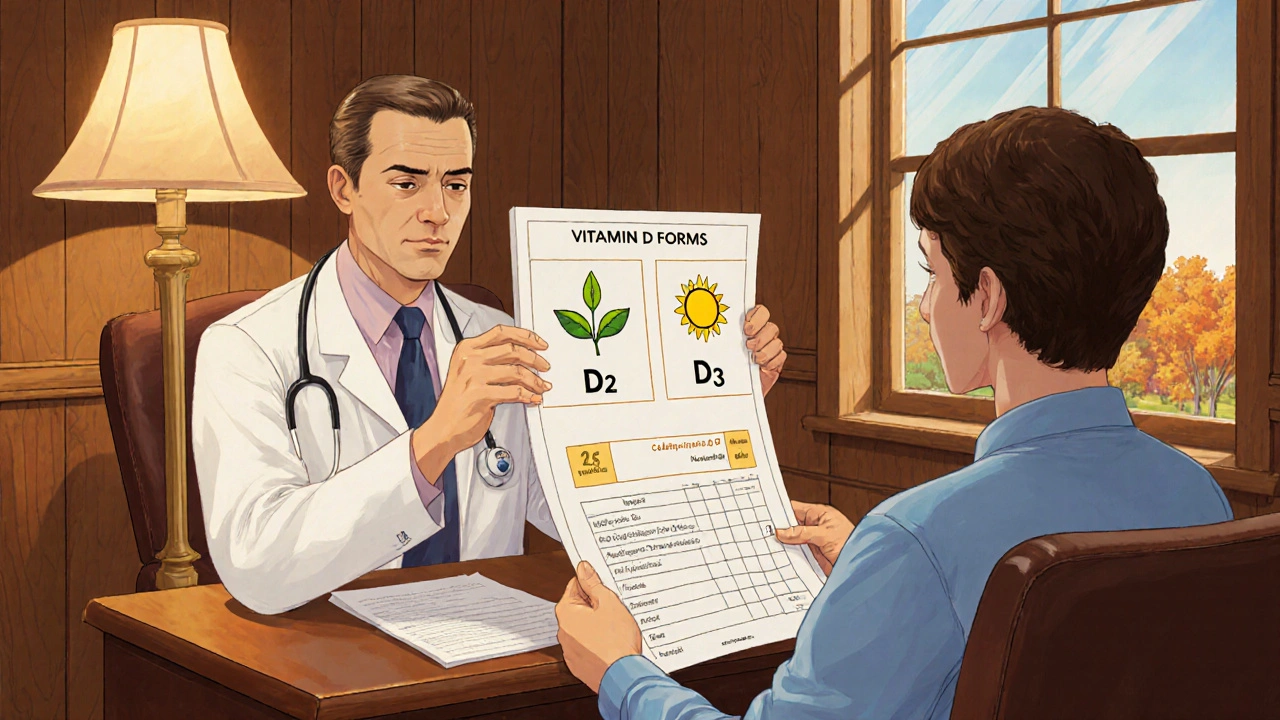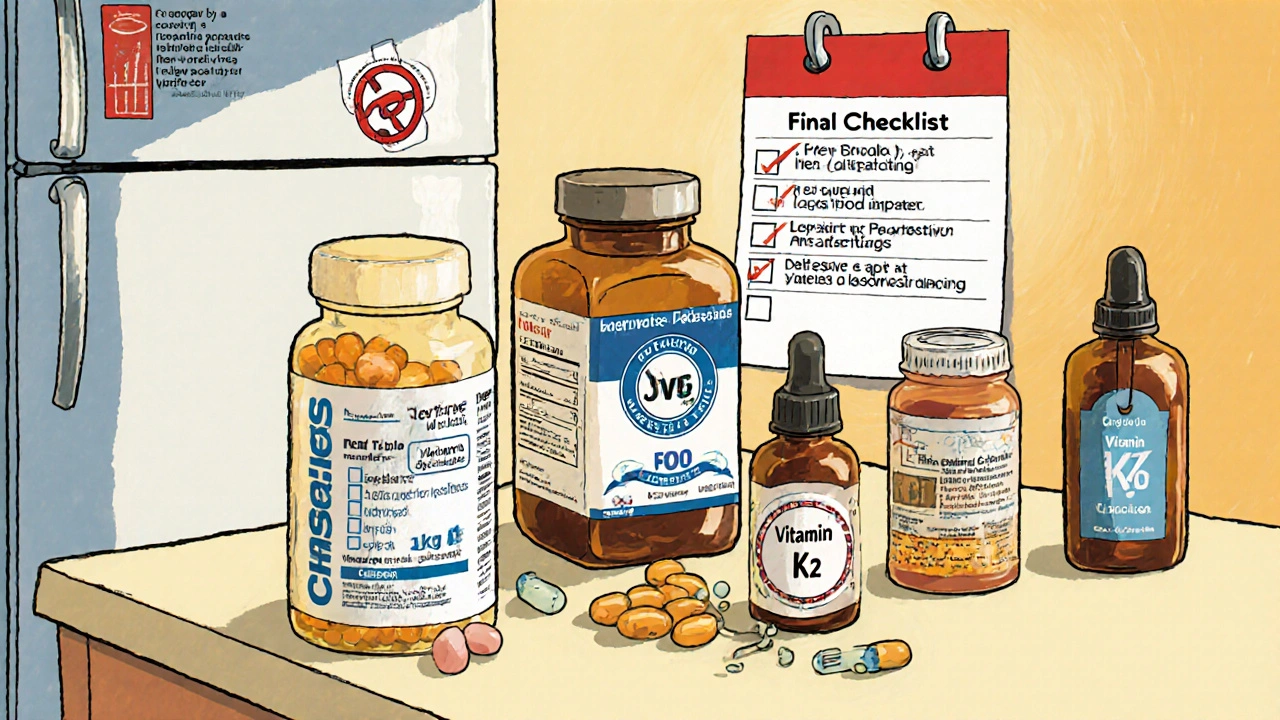Vitamin D Dosage Calculator
This tool calculates your daily vitamin D dosage based on your blood test results and target levels. Note: This is for informational purposes only. Always consult your healthcare provider for personalized medical advice.
Vitamin D supplement is a dietary product designed to boost your body's vitamin D levels, which are essential for bone health, immune function, and mood regulation. With winter evenings getting longer and indoor lifestyles on the rise, many people wonder which supplement actually works for them. This guide walks you through the science, the labels, and the practical bits so you can pick the right option without guesswork.
Why Vitamin D Matters and Who Needs Extra Support
Vitamin D isn’t a single chemical; it’s a family of fat‑soluble compounds that your skin makes when sunlight hits a specific cholesterol precursor. In the UK, average sunlight exposure drops below the threshold for adequate synthesis from October to March, and people who spend most of their time indoors, wear sunscreen, or have deeper skin tones can fall short.
Symptoms of low vitamin D range from subtle (fatigue, bone aches) to serious (osteomalacia, increased infection risk). Blood tests measure 25‑hydroxyvitamin D (25(OH)D). Levels below 20 ng/mL are considered deficient, 20‑30 ng/mL insufficient, and 30‑60 ng/mL sufficient for most health goals.
Understanding the Different Forms of Vitamin D
Not all supplements deliver the same molecule. The three most common forms are:
- Vitamin D2 (ergocalciferol) - plant‑based, produced from lichens. It’s cheaper but generally less potent and shorter‑acting than D3.
- Vitamin D3 (cholecalciferol) - animal‑derived, identical to the compound your skin makes. Most clinicians recommend D3 for its higher bioavailability.
- Calcifediol (25‑hydroxyvitamin D) - the direct blood form. It raises 25(OH)D levels faster, useful for people with malabsorption.
Choosing the right form depends on your health status, dietary preferences, and how quickly you need levels corrected.
How to Determine Your Personal Dosage Needs
First, get a baseline blood test. Your doctor can recommend a target based on age, bone health, and any chronic conditions. General dosage guidelines (for adults) look like this:
- If deficient (<20 ng/mL), aim for 2,000 IU-5,000 IU daily for 8-12 weeks, then reassess.
- If insufficient (20‑30 ng/mL), 800 IU-2,000 IU daily usually suffices.
- For maintenance (30‑60 ng/mL), 800 IU-1,200 IU daily is common.
People at higher risk - older adults, those with osteoporosis, or certain medications like glucocorticoids - may need higher doses, but never exceed 10,000 IU daily without medical supervision.

Quality Signals to Look for on the Label
Because the supplement market isn’t tightly regulated, you need to be a savvy shopper. Key quality markers include:
- Third‑party testing: Look for seals from NSF International, ConsumerLab, or USP. These organizations verify potency and purity.
- Formulation type: Oil‑based softgels improve absorption of the fat‑soluble vitamin.
- Ingredient list: Minimal fillers, no unnecessary additives, and clear allergen information.
- Batch traceability: Lot numbers and manufacturing dates help you verify freshness.
Do You Need Add‑on Nutrients?
Vitamin D works best when paired with certain minerals and vitamins that help the body use it effectively.
- Calcium - needed for bone mineralization. The classic 500 mg to 1,200 mg daily range pairs well with vitamin D.
- Magnesium - a co‑factor for converting vitamin D into its active form. 200 mg-400 mg daily is common.
- Vitamin K2 (MK‑7) - directs calcium to bones instead of arteries, reducing cardiovascular risk.
If you already get these minerals from food, a plain vitamin D supplement is fine. If not, a combined formula can simplify daily routines.
Comparing the Most Popular Vitamin D Supplements (2025)
| Attribute | Vitamin D2 (Ergocalciferol) | Vitamin D3 (Cholecalciferol) | Calcifediol (25‑hydroxyvitamin D) |
|---|---|---|---|
| Source | Plant‑derived (lichens) | Animal‑derived (lanolin or fish oil) | Synthetic or extracted from D3 |
| Bioavailability | Low‑moderate | High - 1.5× D2 | Very high - rapid 25(OH)D rise |
| Typical dose range | 800 IU-2,000 IU | 800 IU-5,000 IU | 10 µg-20 µg (400 IU-800 IU) |
| Best for | Vegan/vegetarian | General population | Malabsorption, rapid correction |
| Safety notes | Higher risk of overdose at equivalent IU | Well‑studied, safe up to 10,000 IU | Requires careful dosing, may raise calcium quickly |

Budget, Convenience, and Lifestyle Fit
Cost varies widely. Bulk softgel bottles of D3 from reputable brands usually run £10‑£20 for 180‑250 IU per capsule. Vegan D2 can be a bit cheaper, but remember the potency trade‑off. If you need a high dose for a short period, a prescription‑strength calcifediol might be pricier but saves you weeks of trial‑and‑error.
Consider how you’ll take it: a daily capsule, a weekly chewable, or a liquid drop. Liquids are handy for kids or people who have trouble swallowing pills, but they often contain added sugars or flavors.
Final Checklist Before Buying
- Confirm your blood 25(OH)D level and target range.
- Decide on form: D3 for most, D2 if vegan, calcifediol for rapid needs.
- Match dosage to your level and health goals.
- Check for third‑party certification (NSF, USP, ConsumerLab).
- Review ingredient list for allergens and unnecessary fillers.
- Consider complementary minerals (calcium, magnesium, K2) if your diet lacks them.
- Factor in price per IU and preferred administration method.
- Set a reminder to re‑test levels after 8‑12 weeks of supplementation.
Following this roadmap takes the guesswork out of the aisle and helps you support bone health, immunity, and overall wellbeing with confidence.
Frequently Asked Questions
How long does it take to see a change in my blood vitamin D level?
With a standard D3 supplement at 2,000 IU daily, most people notice a 5‑10 ng/mL rise after 8‑10 weeks. Calcifediol can boost levels within 2‑3 weeks because it bypasses the liver conversion step.
Can I take vitamin D with any medication?
Most meds are fine, but be cautious with steroids, weight‑loss drugs (orlistat), and anti‑seizure medications, as they can increase the dose you need. Always check with your prescriber.
Is a higher dose always better for bone health?
No. Excess vitamin D can raise calcium too much, leading to kidney stones or vascular calcification. Aim for the target range, not the maximum dose.
Do I need a vegan vitamin D supplement?
If you avoid animal products, choose vitamin D2 or a vegan‑certified D3 derived from lichen. The latter offers better absorption while staying plant‑based.
How often should I test my vitamin D levels?
Re‑test after 8‑12 weeks of a new regimen, then every 6‑12 months if you stay on a stable dose.







prithi mallick
23 October 2025When we contemplate the quiet dance between sunlight and our own biology, it becomes clear that vitamin D is more than a mere supplement-it is a promise of balance, a whisper that our bodies are yearning for the sun's gentle kiss. If you feel the subtle fatigue or the ache in your bones, consider it a sign from the deeper self that something is out of harmony, and a simple blood test can illuminate the path forward. Choosing a D3 source often aligns with the natural rhythm of our skin's own production, while D2 may feel like a distant echo, useful for those who avoid animal products. Remember, the journey to optimal levels is personal; start low, observe, and adjust with a compassionate eye toward your own needs. Definately, the process is a gentle learning curve. May your quest be guided by curiosity and kindness, even if the path feels a bit foggy at first.
Michaela Dixon
26 October 2025Vitamin D is a mosaic of pathways and possibilities that stretches far beyond the simple notion of a pill you swallow each morning. The sun, that ancient fire of creation, paints your skin with cholecalciferol, a molecule that sings in perfect harmony with your liver and kidneys to become the active hormone that regulates calcium. When you step into winter's hush and the daylight retreats, the body’s orchestra can fall silent, and that is where supplementation becomes a quiet conductor. D3, the animal‑derived cholecalciferol, mirrors the sun’s own gift and is generally embraced by clinicians for its higher bioavailability and longer half‑life. D2, the humble plant‑derived ergocalciferol, emerges from lichens and can serve vegans, though its effect often wanes sooner and may require higher doses to achieve the same serum rise. Calcifediol, also known as 25‑hydroxyvitamin D, jumps straight to the bloodstream as the form measured in labs, offering a rapid elevation that can rescue those with malabsorption or severe deficiency. The choice among these forms depends on dietary preference, speed of correction, and medical context, and no single answer fits every individual. Dosage, too, is a delicate balance; a deficit uncovered by a blood test may be addressed with a loading phase of 50,000 IU weekly for eight weeks, followed by a maintenance dose that ranges from 800 to 2000 IU daily, calibrated to keep serum levels between 30 and 60 ng/mL. For those with chronic kidney disease, the active form calcitriol might be prescribed, bypassing the need for renal conversion. Seasonal adjustments can also be wise, as many physicians recommend a modest rise in supplementation from October through March in higher latitudes. It is prudent to pair supplements with a modest intake of healthy fats, because vitamin D is fat‑soluble and requires dietary lipids for optimal absorption; a spoonful of olive oil or a handful of nuts can make a difference. Additionally, certain medications such as glucocorticoids, anticonvulsants, and weight‑loss drugs can accelerate the depletion of vitamin D, signaling a need for closer monitoring. Remember that more is not always better; excessive intake can lead to hypercalcemia, which may manifest as nausea, weakness, and kidney stones, underscoring the importance of regular lab checks. The interplay between sunlight, diet, genetics, and supplementation weaves a rich tapestry that invites personalized care rather than a one‑size‑fits‑all approach. Ultimately, the goal is to nurture a resilient skeleton, a vigilant immune system, and a balanced mood, allowing you to thrive whether the days are bright or dim.
Dan Danuts
30 October 2025Listening to our bodies is key and setting a reminder for an annual blood test can turn that gentle whisper into a clear call‑to‑action. When you see those numbers, celebrate the small wins and adjust the dosage with confidence-your future self will thank you. Let’s keep each other motivated on this journey to brighter bones and brighter moods.
Dante Russello
2 November 2025Thank you for such a thorough exploration of vitamin D, it's a fantastic resource, and I especially appreciate the clarity about the different forms; D3 stands out for its natural alignment with our physiology, D2 offers a plant‑based alternative, while calcifediol provides a rapid boost when needed, and these distinctions are crucial for personalized care! Moreover, the dosage guidelines you highlighted-loading phases, maintenance ranges, seasonal adjustments-serve as a practical roadmap, helping readers navigate the complexities with confidence. Pairing supplements with healthy fats, monitoring medication interactions, and avoiding excess are all vital safeguards; together they create a balanced strategy that respects both efficacy and safety.
Danielle St. Marie
6 November 2025Only the truly informed recognize that Europe’s rigorous fortification standards eclipse the laissez‑faire approach of many other continents 🇪🇺, and anyone still settling for sub‑par D2 supplements should elevate their regimen to certified D3, preferably sourced from the purest Nordic pastures 🌿. Ignorance is a luxury we cannot afford; strive for excellence, lest you fall behind the progressive tide of our great nations.
keerthi yeligay
9 November 2025Definately, a quick test can guide your choice.
Peter Richmond
13 November 2025While your perspective highlights regional standards, it is essential to consider individual health contexts and accessibility; a balanced recommendation respects both scientific evidence and cultural diversity, encouraging informed decisions worldwide.
Bonnie Lin
16 November 2025Exactly, a simple test can set the right path.